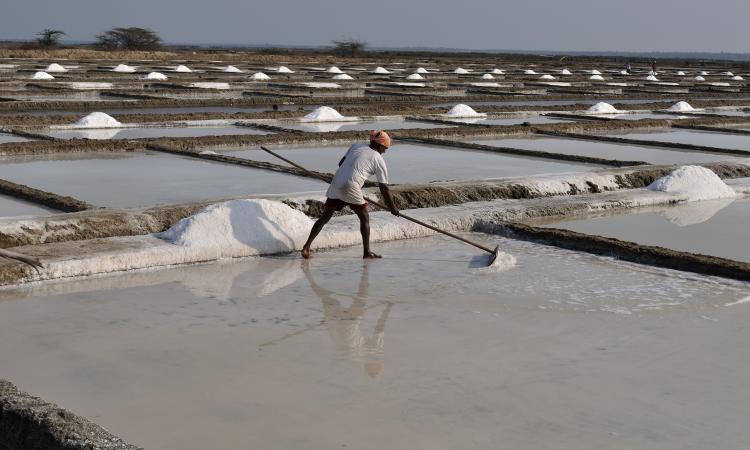
Climate change is expected to increase temperatures by at least 1.5 C around the globe thus increasing the frequency and intensity of heat waves. Increased heat will have a considerable impact on the working population, particularly manual labourers who work in outdoor settings.
India is one of the most vulnerable regions to climate change, with projections of large economic losses because of heat-related illnesses and deaths. A number of studies in India have shown that heat stress can cause health problems among informal workers informs this paper titled 'Occupational heat stress and kidney health in salt pan workers' published in Kidney International Reports.
Heat stress is defined as the total heat generated from the combined contributions of environmental heat, metabolic heat, and clothing. Metabolic heat generation during manual labour in hot climates can increase the risks of the people to health hazards.
Reduced renal function, acute kidney injury, and urolithiasis have all been linked to heat stress from repeated, intense and sustained activity in hot environments, with or without dehydration. Heat stress and dehydration are thought to be major driving forces of chronic kidney disease among manual labourers.
Salt pan work is a common occupation largely done in the informal sector in coastal areas where the manual workers do not have fixed employment terms and workplaces are not formally registered. Tamil Nadu has an estimated 50,000 salt workers who work in hot and humid weather conditions during the salt harvest season. The untraviolet exposures are exceptionally high in the region due to intense sunlight and reflections on white salt, sand, and flat water surfaces.
Work tasks in the salt pans included mud-border making, trampling the ground, salt crystal reshuffling, salt-scrapping, raw salt heaping, loading, packing, crushing, mill operations, and supervision.
The paper discusses the findings of a study that looked at the impact of heat stress on heat-related symptoms and kidney function among salt pan workers working in seven salt pans in Tamil Nadu, India.
The findings
Working conditions
The labourers were largely locals who work in the salt pans on a seasonal basis. The working hours in the salt pans were between 6 AM and 2 PM, with a lunch break of 30 minutes to 1 hour in the open air. The workers did not have any other breaks during active working hours. Apart from sparse vegetation, there were no shaded areas for the workers to rest. The workers brought water bottles from home and could refill them at the workplace, and the sanitation was poor with no toilet facilities.
Health problems experienced by the workers
- Majority of workers (93 percent) reported that they had experienced at least one of the symptoms such as excessive sweating, thirst, dizziness, muscle cramps, headache, nausea/vomiting, fainting, or prickly heat/rashes due to intense heat exposure at the workplace.
- Dry mouth or severe thirst, all of which are signs of dehydration, were found among as high as 59 percent of the workers. Changes in urine volume or color, burning sensations when urinating, rashes, and urinary tract infections were widespread, with 77 percent of the workers reporting at least one of these symptoms.
- Workers brought their own 1-litre water bottle to sip throughout the day and refilled their bottles, but the overall water consumption was very low among the workers.
- The situation was even more difficult for women workers who said that improved toilet access would help them drink more water. One out of every 5 workers had taken sick leave owing to heat-related health difficulties in the last 6 months. A third of the workers said they did not finish their work on time because of the heat resulting in missed income.
- Workers exposed to higher heat stress, or higher workload, more often reported more symptoms of dehydration than those with less demands. Nine out of ten workers were found to work above the limits of heat exposure (WBGT-TLVs) when, according to international regulations, and break periods for the workers were very limited.
- Symptoms of dehydration reported by the salt pan workers increased their risk of kidney diseases. For example, 9 percent of the salt pan workers reported symptoms suggestive of kidney stones, while many also suffered from high blood pressure.
The paper argues that:
- Chronic exposures to heat and strenuous activity creates metabolic heat. This combined with insufficient hydration to compensate for sweat losses, can be risk factors for kidney injury. The workers often consumed very less water and this calls for the need provide palatable water, safe sanitation, and education on the need to hydrate at the workplace.
- Low technology workplace implementations focusing on regulated rests in shade, access to water and sanitation, and an understanding of why this is needed among employers and workers have been shown to reduce heat stress and kidney function loss in industrial agriculture, and can also be implemented in salt pans.
/articles/heat-stress-among-salt-pan-workers-tamil-nadu